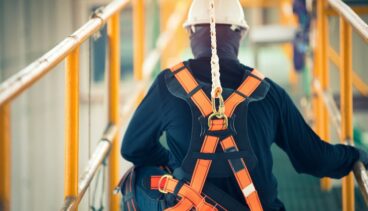Out-of-the Box Ways to Enhance Jobsite Safety
Here’s a sobering statistic: In 2021, nearly 20 percent of all U.S. workplace fatalities happened in the construction industry, according to the U.S. Bureau of Labor Statistics (BLS).
Here’s one even more sobering: According to another source, construction accounts for 36 percent of all U.S. workplace fatalities year by year.
Sobering, yes. But not surprising. Construction work is inherently hazardous. Workers labor outdoors on terrain that may be uneven or unstable There are holes and trenches they can fall into. Weather conditions such as extreme heat, cold, rain, snow, and ice create safety threats of their own. And needless to say, the materials and equipment used in construction can be extremely dangerous. In large scale industrial projects, these risks are only magnified: Heavy equipment such as cranes and bulldozers are quite capable of inflicting injury or death. And working at height always entails serious risks.
Recognizing these issues, the federal Occupational Safety and Health Administration (OSHA), provides safety guidelines and regulations for virtually every facet of the construction process. And those regulations have teeth: Violators face fines starting at $14,502 for each violation and the same amount per day if they fail to remedy the problem. Employers who commit willful or repeated violations can be fined up to $145,027.
These prospects alone would be enough to motivate most contractors to follow good safety procedures. But responsible construction firms are already conscientious about protecting their workers. After all, it makes good business sense—and it’s the right thing to do.
In addition to its regulations, OSHA also requires employers and workers to complete safety training for specific types of construction work. For instance, employees with positions of responsibility or oversight must complete specialized courses. And operators of various types of heavy equipment must complete special OSHA-approved courses. State agencies may add to OSHA’s requirements, and private contractors often have additional requirements of their own.
So, what are the most common safety risks faced by construction workers? Thankfully, there is ample data to show where the major hazards lie…
BIGGEST THREATS TO JOBSITE SAFETY
OSHA lists falls from height as one of its ”Top Four” causes of construction worksite fatalities. In fact, falls are responsible for about 40 percent of construction deaths. So, construction contractors naturally focus a lot of attention on this hazard, employing a range of safety procedures and equipment.
Equipment used to prevent fall injuries includes:
PERSONAL FALL ARREST SYSTEMS

SAFETY NETS

GUARDRAILS

CANOPIES

SEATBELTS

LANYARDS

SAFETY TOE BOARDS

ENHANCING JOBSITE SAFETY: BASIC PROTOCOLS

Responsible companies have written safety protocols that they require employees to be familiar with. Workers and supervisors must be instructed in the proper use of tools, ladders, scaffolding, and other equipment. They should be familiar with the appropriate safety gear and be required to wear it. In addition, regular safety meetings involving all employees can drive home the importance of following good procedures.
But these are just the beginning. Smart companies take their safety precautions a step further, with additional practices and the technical solutions that are now available.
NEXT-LEVEL SAFETY INNOVATIONS

Smart helmets combine the protection of a traditional hardhat with technological features that enhance worker safety as well as efficiency. They incorporate sensors, tracking tools, and depth-sensing cameras that warn the wearers when they are close to hazardous locations. Health monitoring technology tracks the wearers’ vital statistics and cognitive state, alerting them when they may be dangerously exhausted.
Smart vests perform a similar function in monitoring the wearers’ physiological state. They use electrocardiogram (ECG) and photoplethysmogram (PPG) technology to collect real-time medical data, along with the wearers’ body temperature, blood pressure, galvanic skin response (GSR) and heart rate.
Another tool builders can use in their efforts to enhance workplace safety is four-dimensional building information modeling (4D-BIM). This technology enables companies to build virtual replicas of a site layout and identify potential hazards beforehand. They can create safety plans while a project is still in the planning and design stage.
THE KEY TO ENHANCED JOBSITE SAFETY: PEOPLE

The best way to ensure safety on a worksite is to make sure everyone is invested in the same goals. Collaborative safety planning involving all personnel can encourage employee buy-in, transforming the topic of safety from a boring distraction to a shared priority. When employees understand the risks they face and the real human cost of a safety incident, they will generally embrace common sense measures and more extensive training.
Taking a few minutes each morning to focus on health and safety issues can pay off happily in the long run. Rainwater Construction Company has made this a longstanding policy, beginning each workday with a regimen of stretching and warmups.
Jobsite safety should never be an afterthought. It should always be the top priority. Today’s knowledge and technology make it more achievable than ever.
RAINWATER CONSTRUCTION IS A SAFETY-FIRST COMPANY.
READ THIS NEXT
Stay up to date on the latest Rainwater Construction news and event – follow us on LinkedIn!


